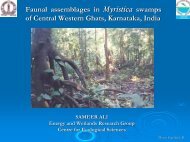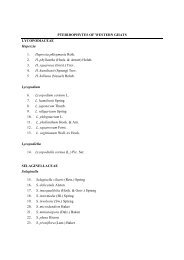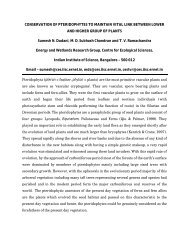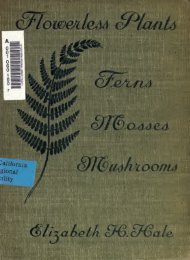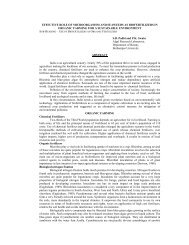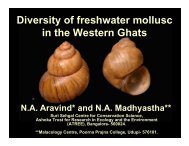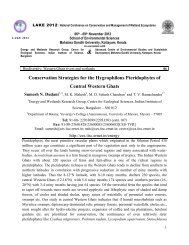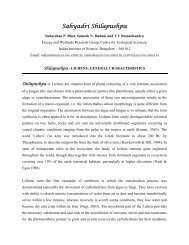regional wood energy development programme in asia ... - CES (IISc)
regional wood energy development programme in asia ... - CES (IISc)
regional wood energy development programme in asia ... - CES (IISc)
Create successful ePaper yourself
Turn your PDF publications into a flip-book with our unique Google optimized e-Paper software.
With<strong>in</strong> the four ma<strong>in</strong> supply areas there are 6 six ma<strong>in</strong> villages and five nearby villages,<br />
from where labour is drawn, which can be considered as <strong>wood</strong>fuel supply centres. The population<br />
size and the number of households as well as the number of people engaged <strong>in</strong> <strong>wood</strong>fuel<br />
gatherer<strong>in</strong>g and trad<strong>in</strong>g, etc. <strong>in</strong> these villages, are shown <strong>in</strong> table 4.1. Most of the people <strong>in</strong> the 11<br />
villages, engaged <strong>in</strong> fuel collection and trade, are primarily farmers. However, for generations they<br />
have been supplement<strong>in</strong>g their <strong>in</strong>come, <strong>in</strong> particular dur<strong>in</strong>g the off-farm season, by extract<strong>in</strong>g forest<br />
products.<br />
Table 4.1 Villages engaged <strong>in</strong> <strong>wood</strong>fuel collection and trade <strong>in</strong> the study area.<br />
Village/<br />
Sub-village<br />
Hla<strong>in</strong>gdet<br />
Thahtaygon<br />
Kywetatson<br />
Y<strong>in</strong>mab<strong>in</strong><br />
- Madan<br />
- Monp<strong>in</strong>son<br />
Yebokson<br />
- Kuby<strong>in</strong><br />
- Monp<strong>in</strong><br />
- Oakky<strong>in</strong><br />
Py<strong>in</strong>yaung<br />
No. of<br />
Households<br />
1,408<br />
77<br />
197<br />
768<br />
90<br />
150<br />
229<br />
21<br />
51<br />
59<br />
313<br />
Population<br />
size<br />
7,044<br />
511<br />
1,063<br />
4,097<br />
572<br />
976<br />
1,195<br />
79<br />
225<br />
322<br />
1,376<br />
12<br />
No. of people regularly engaged <strong>in</strong><br />
Trade Collection Total<br />
13<br />
2<br />
3<br />
10<br />
n.a.<br />
n.a.<br />
6<br />
n.a.<br />
n.a.<br />
n.a.<br />
17<br />
100<br />
40<br />
110<br />
176<br />
n.a.<br />
n.a.<br />
130<br />
n.a.<br />
n.a.<br />
n.a.<br />
91<br />
113<br />
42<br />
113<br />
186<br />
n.a.<br />
n.a.<br />
136<br />
n.a.<br />
n.a.<br />
n.a.<br />
108<br />
Total 3,363 17,460 51 647 698<br />
As shown <strong>in</strong> figure 4.1, the <strong>wood</strong>fuel resource areas lie along the highway and the railway<br />
l<strong>in</strong>e that connect the Central Dry Zone and the Shan State. The six ma<strong>in</strong> collection and supply<br />
centres are all located along these transport ways between Py<strong>in</strong>yaung and Meiktila. Both the<br />
highway and the railway are used to transport <strong>wood</strong>fuels to Meiktila which lies at a distance of<br />
about 50 miles from the supply area.<br />
4.1 The Ma<strong>in</strong> Collection and Trade Centres<br />
4.1.1 Hla<strong>in</strong>gdet Village<br />
Hla<strong>in</strong>gdet is the largest trade and collection centre <strong>in</strong> the area. It is located about 7 miles<br />
from Thazi and 21 miles from Meiktila. The centre specializes <strong>in</strong> bamboo and there are about 100<br />
regular fuel gatherers who work for the 13 traders. Bamboo is collected from the Yupadaung<br />
Reserve which is located about 3 miles from the village. S<strong>in</strong>ce 1970 the village has been supply<strong>in</strong>g<br />
bamboo for use as fuel to the evaporated milk <strong>in</strong>dustries <strong>in</strong> Thazi, Meiktila, Pyawbwe and Wundw<strong>in</strong>.<br />
In fact, Hla<strong>in</strong>gdet can be considered as the pioneer <strong>in</strong> promot<strong>in</strong>g the use of bamboo as a substitute<br />
source of <strong>energy</strong> for the production of evaporated milk <strong>in</strong> the dry zone.



